
Walcheren is a region and former island in the Dutch province of Zeeland at the mouth of the Scheldt estuary. It lies between the Eastern Scheldt in the north and the Western Scheldt in the south and is roughly the shape of a rhombus. The two sides facing the North Sea consist of dunes and the rest of its coastline is made up of dykes. Middelburg, the provincial capital, lies at Walcheren's centre. Vlissingen, 9 kilometres (5.6 mi) to the south, is the main harbour and the third municipality is Veere.

Arcen en Velden is a former town and former municipality in the southeastern Netherlands, now part of the municipality and city of Venlo. It is situated in the province of Limburg.
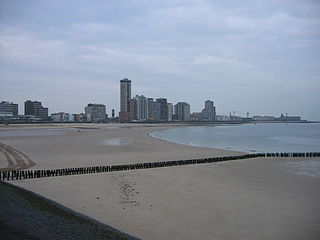
Vlissingen, historically known in English as Flushing, is a municipality and a city in the southwestern Netherlands on the former island of Walcheren. With its strategic location between the Scheldt river and the North Sea, Vlissingen has been an important harbour for centuries. It was granted city rights in 1315. In the 17th century Vlissingen was a main harbour for ships of the Dutch East India Company (VOC). It is also known as the birthplace of Admiral Michiel de Ruyter.

The Battle of the Downs took place on 21 October 1639, during the Eighty Years' War. A Spanish fleet, commanded by Admiral Antonio de Oquendo, was decisively defeated by a Dutch force under Lieutenant-Admiral Maarten Tromp. Victory ended Spanish efforts to re-assert naval control over the English Channel and confirmed Dutch dominance of the sea lanes, while it is also alleged to be the first major action to feature line of battle tactics.
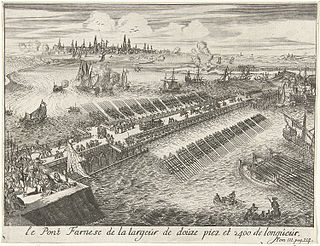
The fall of Antwerp on 17 August 1585 took place during the Eighty Years' War, after a siege lasting over a year from July 1584 until August 1585. The city of Antwerp was the focal point of the Protestant-dominated Dutch Revolt, but was forced to surrender to the Spanish forces under the command of Alessandro Farnese. Under the terms agreed, all the Protestants of Antwerp were given four years to settle their affairs and leave the city. Many migrated north, especially to Amsterdam, which became the capital of the Dutch Republic. Apart from losing a high proportion of its middle class and mercantile population, Antwerp's trade suffered for two centuries afterwards as Dutch forts blockaded the River Scheldt until 1795.
The naval Battle of Puerto de Cavite took place on 10 June 1647 during the Eighty Years' War between a Spanish fleet and a Dutch fleet in Puerto de Cavite, an important Spanish port in Manila Bay, Philippines in which the Dutch were defeated.

The Spanish Armada was a Spanish fleet that sailed from Lisbon in late May 1588, commanded by the Alonso de Guzmán, Duke of Medina Sidonia, an aristocrat without previous naval experience appointed by Philip II of Spain. His orders were to sail up the English Channel, join with the Duke of Parma in Flanders, and escort an invasion force that would land in England and overthrow Elizabeth I. Its purpose was to reinstate Catholicism in England, end support for the Dutch Republic, and prevent attacks by English and Dutch privateers against Spanish interests in the Americas.

The Battle on the Zuiderzee was a naval battle during the Eighty Years' War in which a Dutch fleet destroyed a larger and better-equipped Spanish fleet on the Zuiderzee.

The Battle of the Scheldt also known as the Battle of Walcheren was a naval battle that took place on 29 January 1574 during the Eighty Years' War and the Anglo–Spanish War. The battle was fought between a Dutch rebel Sea Beggar fleet under Lodewijk van Boisot and a Spanish fleet under Julián Romero. The Spanish fleet was attempting to relieve the Spanish held town of Middelburg which was under siege but the fleet under Boisot intercepted them and were victorious with the destruction or capture of nearly fifteen ships. Middelburg as a result then surrendered only nine days later along with Arnemuiden.

The Battle of Sluis was a naval battle during the Eighty Years' War in which a Spanish squadron commanded by the Italian captain Federico Spinola tried to break through a blockade of Sluis by Dutch ships under the command of Joos de Moor. After about two hours of fighting the heavily damaged Spanish ships returned to Sluis; Federico Spinola was killed during the action.

The Battle of the Terek River was the last major battle of the Tokhtamysh–Timur war. It took place on 14 April 1395, at the Terek River, North Caucasus. The result was a victory for Timur.

The Capture of Cádiz in 1596 was an event during the Anglo-Spanish War, when English and Dutch troops under Robert Devereux, 2nd Earl of Essex, and a large Anglo-Dutch fleet under Charles Howard, 1st Earl of Nottingham, with support from the Dutch United Provinces, raided the Spanish city of Cádiz.
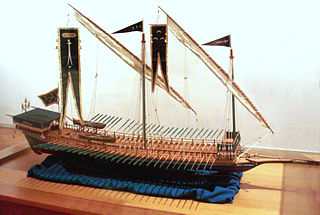
The Battle of Formentara occurred on 28 October 1529 when an Ottoman fleet under Aydin Reis routed a small Spanish fleet of eight galleys off the island of Formentera near Ibiza.

The Battle of Gibraltar took place on 10 August 1621, during the Eighty Years' War between the Spanish Empire and the Dutch Republic. A Dutch East India Company fleet, escorted by a squadron under Willem Haultain de Zoete, was intercepted and defeated by nine ships of Spain's Atlantic fleet under Fadrique de Toledo while passing the Strait of Gibraltar.

The Battle of Haarlemmermeer was a naval engagement fought on 26 May 1573, during the early stages of the Dutch War of Independence. It was fought on the waters of the Haarlemmermeer – a large lake which at the time was a prominent feature of North Holland.

In August 1572, during the course of the Eighty Years' War, the city of Goes, in the Spanish Netherlands, was besieged by Dutch forces with the support of English troops sent by Queen Elizabeth I. This was a menace to the safety of the nearby city of Middelburg, also under siege. Given the impossibility of rescue of Goes by sea, 3,000 soldiers of the Spanish Tercios under the command of Cristóbal de Mondragón waded across the river Scheldt at its mouth, walking 15 miles overnight in water up to chest deep. The surprise arrival of the Tercios forced the withdrawal of the Anglo-Dutch troops from Goes, allowing the Spanish to maintain control of Middelburg, capital of Walcheren Island.
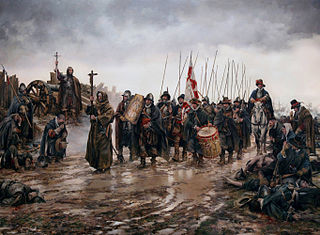
The Miracle of Empel was an unexpected Spanish victory on December 8, 1585, near Empel, in the Netherlands, as part of the Eighty Years' War, in which a surrounded Spanish force managed to escape when the waters around their island suddenly froze.

The battle of Zierikzee was a naval battle between a Flemish fleet and an allied Franco-Hollandic fleet which took place on 10 and 11 August 1304. The battle, fought near the town of Zierikzee, ended in a Franco-Dutch victory. The battle is part of a larger conflict between the Count of Flanders and his French feudal lord, King Philip IV of France (1296–1305).
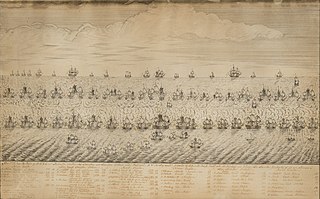
Battle of Rügen was a major naval battle fought on August 8, 1715 off Jasmund on the Swedish island of Rügen during the Great Northern War.

The siege of Middelburg (1572–1574) lasted over a year during the Eighty Years' War. A Dutch rebel army with the support of the English laid siege to Middelburg, which was being held by Spanish forces under Cristóbal de Mondragón, on 4 November 1572. The Spanish held out and only capitulated on 18 February 1574, when news arrived that a relief effort to save Middelburg was defeated at Rimmerswiel.



















